|
|

|
 |
| Forum: | Satellites - Robotic Probes |
| Topic: | NASA%2FESA Mars sample return missions |
|
| Want to register?
|
If you have previously registered, but forgotten your password, click here.
In fact, the supersonic splitline nozzle has achieved the sixth of nine technology readiness levels – known as TRL-6 -- developed by NASA. TRL-1 is the starting point at which there is just an idea for a new technology, while TRL-9 means the technology has been developed, tested, and successfully used for an in-space mission. Davis said the supersonic splitline nozzle achieved TRL-6 through vacuum bench testing and full-scale hot fire testing in April. Results are being independently evaluated and will be confirmed in August. The supersonic splitline nozzle will also undergo qualification testing to make sure it can handle the intense shaking and vibration of launch, the near vacuum of space, and the extreme heat and cold expected during MAV's trip. In addition to motor testing, the MAV team recently conducted its Preliminary Design Review, which was a four-day, in-depth review of MAV's overall design. Mars Ascent Vehicle Project Manager Stephen Gaddis said MAV passed that review, which means the team can now focus on continuing to improve MAV before its Critical Design Review next summer. NASA Marshall is designing, building, and testing MAV along with the project's two primary contractors, Lockheed Martin Space and Northrop Grumman. Lockheed Martin Space is the overall system integrator and provides multiple subsystems, and Northrop Grumman provides the first stage and second stage main propulsion systems. The Mars Sample Return Program is managed by NASA's Jet Propulsion Laboratory (JPL) in Southern California. | | Robert Pearlman | NASA release NASA Sets Path to Return Mars Samples, Seeks Innovative DesignsNASA Administrator Bill Nelson shared on Monday the agency's path forward on the Mars Sample Return program, including seeking innovative designs to return valuable samples from Mars to Earth. Such samples will not only help us understand the formation and evolution of our solar system but can be used to prepare for future human explorers and to aid in NASA's search for signs of ancient life.
Over the last quarter century, NASA has engaged in a systematic effort to determine the early history of Mars and how it can help us understand the formation and evolution of habitable worlds, including Earth. As part of that effort, Mars Sample Return has been a long-term goal of international planetary exploration for the past two decades. NASA's Perseverance rover has been collecting samples for later collection and return to Earth since it landed on Mars in 2021.
"Mars Sample Return will be one of the most complex missions NASA has ever undertaken. The bottom line is, an $11 billion budget is too expensive, and a 2040 return date is too far away," said Nelson. "Safely landing and collecting the samples, launching a rocket with the samples off another planet – which has never been done before – and safely transporting the samples more than 33 million miles back to Earth is no small task. We need to look outside the box to find a way ahead that is both affordable and returns samples in a reasonable timeframe."
The agency also has released NASA's response to a Mars Sample Return Independent Review Board report from September 2023. This includes: an updated mission design with reduced complexity; improved resiliency; risk posture; stronger accountability and coordination; and an overall budget likely in the $8 billion to $11 billion range. Given the Fiscal Year 2025 budget and anticipated budget constraints, as well as the need to maintain a balanced science portfolio, the current mission design will return samples in 2040.
To achieve the ambitious goal of returning the key samples to Earth earlier and at a lower cost, the agency is asking the NASA community to work together to develop a revised plan that leverages innovation and proven technology. Additionally, NASA soon will solicit architecture proposals from industry that could return samples in the 2030s, and lowers cost, risk, and mission complexity.
"NASA does visionary science – and returning diverse, scientifically-relevant samples from Mars is a key priority," said Nicky Fox, associate administrator, Science Mission Directorate, at NASA Headquarters in Washington. "To organize a mission at this level of complexity, we employ decades of lessons on how to run a large mission, including incorporating the input we get from conducting independent reviews. Our next steps will position us to bring this transformational mission forward and deliver revolutionary science from Mars -- providing critical new insights into the origins and evolution of Mars, our solar system, and life on Earth." | | Robert Pearlman | NASA release NASA Exploring Alternative Mars Sample Return MethodsNASA is moving forward with ten studies to examine more affordable and faster methods of bringing samples from Mars' surface back to Earth as part of the agency's Mars Sample Return Program. As part of this effort, NASA will award a firm-fixed-price contract for up to $1.5 million to conduct 90-day studies to seven industry proposers.
Additionally, NASA centers, CalTech's Jet Propulsion Laboratory, and Johns Hopkins' Applied Physics Laboratory are producing studies. Once completed, NASA will assess all studies to consider alterations or enhancements to the Mars Sample Return architecture. "Mars Sample Return will be one of the most complex missions NASA has undertaken, and it is critical that we carry it out more quickly, with less risk, and at a lower cost," said Nelson. "I'm excited to see the vision that these companies, centers and partners present as we look for fresh, exciting, and innovative ideas to uncover great cosmic secrets from the Red Planet."
Over the last quarter century, NASA has engaged in a systematic effort to determine the early history of Mars and how it can help us understand the formation and evolution of habitable worlds, including Earth. As part of that effort, Mars Sample Return has been a long-term goal of international planetary exploration for the past two decades. NASA's Perseverance rover has been collecting samples for later collection and return to Earth since it landed on Mars in 2021.
The following companies and proposals were selected from among those that responded to an April 15 request for proposals: - Lockheed Martin in Littleton, Colorado: "Lockheed Martin Rapid Mission Design Studies for Mars Sample Return"
- SpaceX in Hawthorne, California: "Enabling Mars Sample Return With Starship"
- Aerojet Rocketdyne in Huntsville, Alabama: "A High-Performance Liquid Mars Ascent Vehicle, Using Highly Reliable and Mature Propulsion Technologies, to Improve Program Affordability and Schedule"
- Blue Origin in Monrovia, California: "Leveraging Artemis for Mars Sample Return"
- Quantum Space, in Rockville, Maryland: "Quantum Anchor Leg Mars Sample Return Study"
- Northrop Grumman in Elkton, Maryland: "High TRL MAV Propulsion Trades and Concept Design for MSR Rapid Mission Design"
- Whittinghill Aerospace in Camarillo, California: "A Rapid Design Study for the MSR Single Stage Mars Ascent Vehicle"
NASA's Mars Sample Return is a strategic partnership with ESA (the European Space Agency). Returning scientifically selected samples to Earth for study using the most sophisticated instruments around the world can revolutionize our understanding of Mars and would fulfill one of the highest priority solar system exploration goals as identified by the National Academies of Science, Engineering and Medicine. | | Robert Pearlman | European Space Agency (ESA) release Europe's Earth Return Orbiter reaches design maturityESA's Earth Return Orbiter, the first spacecraft that will rendezvous and capture an object around another planet, passed a key milestone to bring the first Mars samples back to Earth. 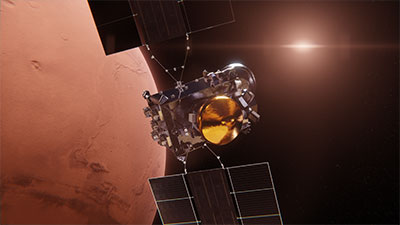 Above: Artist impression of the Earth Return Orbiter (ERO). (ESA) The critical design review for the spacecraft's platform was completed today with the involvement of European industry and NASA. A critical design review is one of the most important phases in any spaceflight project to make a spacecraft a reality. The Platform Critical Design Review (P-CDR) confirmed the performance, quality and reliability of the systems for this unprecedented mission to Mars. 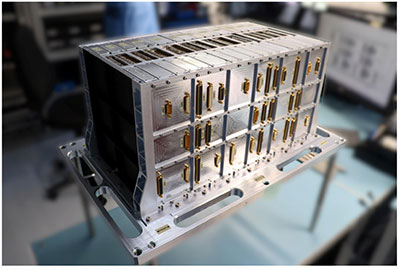 Above: Engineering qualification model of the Remote Interface Unit (RIU) for the Earth Return Orbiter. (ESA) The Earth Return Orbiter (ERO) is ESA's major contribution to the Mars Sample Return campaign, a complex choreography of missions to bring martian rock, soil and atmospheric samples back to Earth. Europe ready for Mars The validation of the design and technical details represent a formal step towards the integration phase. "European industry is ready for the next chapter. A robust design is the foundation for building, testing and assembling the hardware into a complete spacecraft," says Tiago Loureiro, ERO's project team leader. 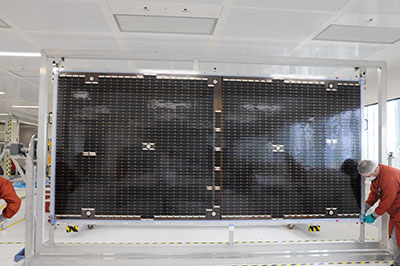 Above: First solar array panel for ESA's Earth Return Orbiter (ERO). (ESA) The manufacturing and testing of the components of the spacecraft can now start to ensure the mission moves ahead for launch. Suppliers from 11 European countries are on board for building the parts of an orbiter set for a full round-trip from Earth to Mars. The challenges NASA announced plans to update the Mars Sample Return programme last April with reduced complexity, risk and cost, including innovative designs and proven technology to return valuable samples from Mars to Earth. ESA technical teams worked closely with their NASA counterparts to prepare for a revision of the programme. "The configuration of the spacecraft is robust enough to be flexible with the cargo and to help finding solutions for a new architecture. ESA and our industrial partners adapted to a new scenario, staying inventive and resourceful while remaining a reliable partner for NASA," explains Tiago. "We have confirmed that the Earth Return Orbiter works for what was planned to do and more, whatever the alternatives are," he adds. The magic The Earth Return Orbiter has the essential role of bringing samples from Mars back to Earth, but before doing that, it must find them in space. 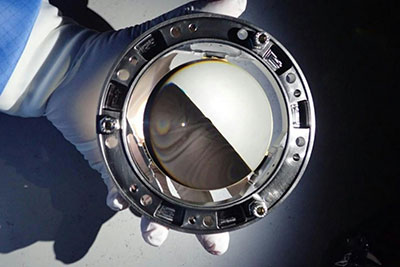 Above: Lens of the narrow angle camera model used to detect the Orbiting Sample in low Mars orbit. (ESA) ERO's design demonstrated with flying colours that it is capable of capturing a basketball-sized capsule filled with samples collected by NASA's Perseverance rover. "This mission exemplifies European technological prowess at its finest. From a staggering distance of up to several hundred million kilometres, Earth-based teams will choreograph a complex orbital dance around Mars," says Orson Sutherland, ESA's Mars programme manager. Their challenge: to locate a tiny capsule, maneuver into the precise orbit for rendezvous, and successfully capture it – all while operating remotely across the vast expanse of space. ERO's five-year mission to Mars and back will also see the spacecraft acting as a communication relay with rovers and landers on the surface. European excellence Teams in Europe rely on already mature technologies in autonomous navigation, rendezvous and docking, an expertise built up over decades from missions like the Automated Transfer Vehicle and Europe's first mission to Jupiter with JUICE. Knowledge from the ExoMars Rosalind Franklin rover mission to the Red Planet is also feeding into it. 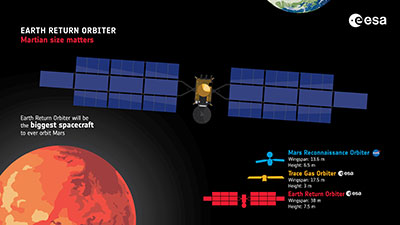 Above: The Earth Return Orbiter (ERO) will be the biggest spacecraft to ever orbit Mars. The spacecraft will also be the first interplanetary spacecraft to rendezvous and capture a man-made object launched from another planet and return it to the Earth's surface, making a full round trip to Mars and back. (ESA) ERO will be the largest spacecraft ever built for interplanetary flight. Contributions come from France, Italy, Germany, UK, Spain, Switzerland, Norway, Denmark, Belgium, Romania, and The Netherland Airbus Defence and Space has overall responsibility for the ERO mission to build the spacecraft and to conduct mission analysis from France, Germany and the UK. Thales Alenia Space will play an important role in assembling the spacecraft, developing the communication system and providing the orbit insertion module from its plant in Turin, Italy. | | Robert Pearlman | NASA release NASA to Explore Two Landing Options for Returning Samples from MarsTo maximize chances of successfully bringing the first Martian rock and sediment samples to Earth for the benefit of humanity, NASA announced Tuesday a new approach to its Mars Sample Return Program. The agency will simultaneously pursue two landing architectures, or strategic plans, during formulation, encouraging competition and innovation, as well as cost and schedule savings. 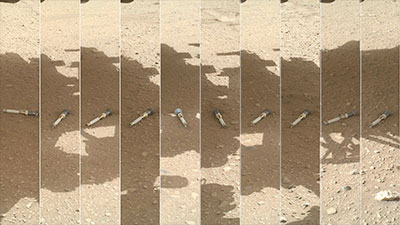 Above: This photomontage shows tubes containing samples from Mars, as collected by NASA’s Perseverance Mars rover. The agency’s Mars Sample Return Program plans to bring these samples back to study them in state-of-the-art facilities on Earth. (NASA/JPL-Caltech/MSSS) NASA plans to later select a single path forward for the program, which aims to better understand the mysteries of the universe, and to help determine whether the Red Planet ever hosted life. NASA is expected to confirm the program – and its design – in the second half of 2026. "Pursuing two potential paths forward will ensure that NASA is able bring these samples back from Mars with significant cost and schedule saving compared to the previous plan," said NASA Administrator Bill Nelson. "These samples have the potential to change the way we understand Mars, our universe, and – ultimately – ourselves. I'd like to thank the team at NASA and the strategic review team, led by Dr. Maria Zuber, for their work." In September 2024, the agency accepted 11 studies from the NASA community and industry on how best to return Martian samples to Earth. A Mars Sample Return Strategic Review team was charged with assessing the studies and then recommending a primary architecture for the campaign, including associated cost and schedule estimates. "NASA's rovers are enduring Mars' harsh environment to collect ground-breaking science samples," said Nicky Fox, who leads NASA's Science Mission Directorate. "We want to bring those back as quickly as possible to study them in state-of-the-art facilities. Mars Sample Return will allow scientists to understand the planet's geological history and the evolution of climate on this barren planet where life may have existed in the past and shed light on the early solar system before life began here on Earth. This will also prepare us to safely send the first human explorers to Mars." During formulation, NASA will proceed with exploring and evaluating two distinct means of landing the payload platform on Mars. The first option will leverage previously flown entry, descent, and landing system designs, namely the sky crane method, demonstrated with the Curiosity and Perseverance missions. The second option will capitalize on using new commercial capabilities to deliver the lander payload to the surface of Mars. For both potential options, the mission's landed platform will carry a smaller version of the Mars Ascent Vehicle. The platform's solar panels will be replaced with a radioisotope power system that can provide power and heat through the dust storm season at Mars, allowing for reduced complexity. The orbiting sample container will hold 30 of the sample tubes containing samples the Perseverance lander has been collecting from the surface of Mars. A redesign of the sample loading system on the lander, which will place the samples into the orbiting sample container, simplifies the backward planetary protection implementation by eliminating the accumulation of dust on the outside of the sample container. Both mission options rely on a capture, containment and return system aboard ESA's (European Space Agency's) Earth Return Orbiter to capture the orbiting sample container in Mars orbit. ESA is evaluating NASA's plan. | |







